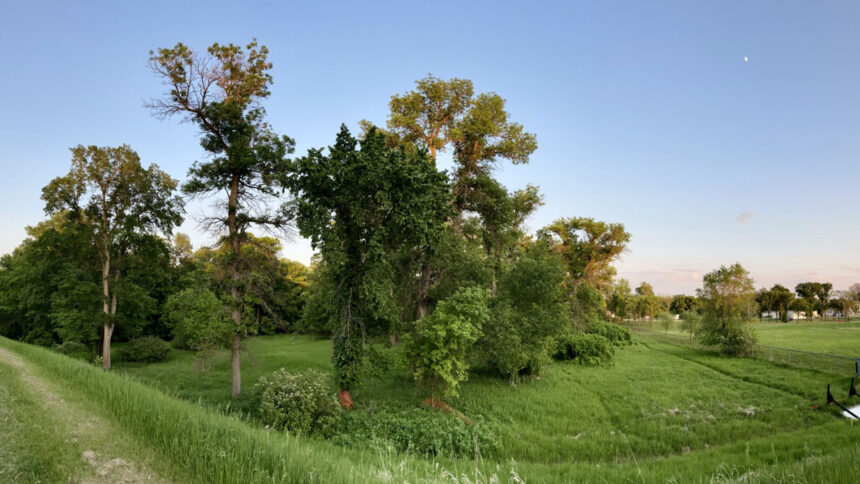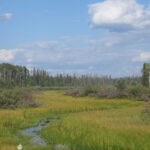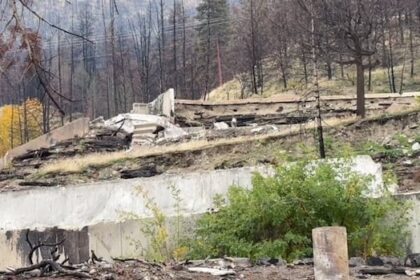In Winnipeg’s St. Norbert neighbourhood, the passionate fight to protect a 22-acre urban forest from a developer’s plan to raze it for a housing project culminated in expropriation by the provincial government. The grassroots effort to save the Lemay Forest – a rich wilderness enclave with sweat lodges and a forgotten cemetery behind a former Catholic orphanage – is the focus of Cherished Woods: The Fight to Save Lemay on APTN Investigates. “My sister said, ‘how about we hang some clothes, try to get 3,000 pieces of clothes up to the line and all the way through, kind of symbolizing each one of those children that are in there and why we’re here, bring people to come talk to us,’” says Diane Bousquet about a commemorative art installation that has marked the way into Lemay Forest for several months. Records suggest these woods are where many children, including unknown numbers of Métis, remain in unmarked graves. Bousquet and others stood their ground as men with chainsaws and other equipment tried to get in and cut down trees. And then on April 14 Manitoba Premier Wab Kinew made an announcement. “There’s been a lot of controversy here with people worried about the cemetery, the history and endangered species, and of course, about the forest itself,” says Kinew in a widely shared TikTok. “Your provincial government is stepping in to protect Lemay. We’re going to expropriate this area to make it a beautiful new provincial park for us all to enjoy, to celebrate our shared history, and of course to make that future together as Manitobans.” The edge of the Lemay Forest with the former Asile Ritchot visible on the right side. Photo: Christopher Read/APTN. A count done by archivists at the St. Boniface Historical Society finds that 3,383 children died at the former orphanage known as Asile Ritchot when it operated between 1904 and 1948. That averages out over 44 years to a death rate of 77 children per year. The records also indicate 31 of the dead were identified as Métis, but there may have been more, according to Shelley Sweeney, Archivist Emerita at the University of Manitoba – who has been studying the Asile Ritchot records in depth. “First of all, people were reluctant to admit it by that point and then there were also children that were being abandoned at the home and where would you expect most of the people to come from would be the neighboring community and that was a Métis community,” says Sweeney. Part of the mystery still to be investigated surrounds the question of where these almost 3,400 dead orphans ended up. Records uncovered so far account for just 726 children buried in the orphanage cemetery, between 1904 and 1912. Of the ones buried in the cemetery, Sweeney says there is a clue in a burial register about where they are. “This is in the writing, the handwriting of one of the sisters and she says that each year they will open a large pit for the bodies of the children,” says Sweeney. A lidar scan done by the province in 2020 shows evidence of what seems to be the pit graves in the cemetery area. Lidar stands for Light Detection and Ranging and it works on the principle of radar, but uses light from a laser to examine the Earth’s surface. The Behavioural Health Foundation, an addiction treatment facility, now occupies this building which from 1904 to 1948 housed the Asile Ritchot, an orphanage run by the Sisters of the Misericorde. Photo: Rob Smith/APTN. The St. Boniface Historical Society is planning to investigate their archives further in the coming months to try to better understand what happened at the Asile Ritchot. As Sweeney notes, the number of dead at the Sisters of the Misericorde-run orphanage is difficult to fathom. “If you compare the numbers of children that died at the Asile Ritchot, it’s overwhelming,” says Sweeney. “It’s far greater than the numbers in other institutions even, and certainly much greater than in the average population.” It seems possible, says Sweeney, that the Sisters took on a bigger challenge than they could manage. “They were expecting to have 30 babies to look after – and at that point, there was, I think, four sisters that were looking after the children,” says Sweeney. “And by 1911, they had to build an entirely new building that’s attached to the original house. You know, the population just exploded.” The close quarters for the infants and children may have created a perfect situation for the spread of disease. “It would rip through the entire institution, I would imagine, given how close the children were packed in there,” says Sweeney. “And then there’s always the possibility that they were getting contaminated water that was from the Red River or contaminated by Red River water. “And so typhoid, for example, or enteritis, that’s a frequent listing in the death registers.” University of Manitoba Archivist Emerita Shelley Sweeney at the edge of Lemay Forest where children from the Asile Ritchot orphanage were buried. Photo: Christopher Read/APTN. A series of three provincial government reports from 1945 recently uncovered by the St. Boniface Historical Society and seen by APTN Investigates, paint a grim picture of life at the Asile, the French word for asylum. Investigators found children looked “pale and listless” and that “their care left much to be desired” – and that “the whole atmosphere in the home is depressing and the staff interviewed appear insecure, lethargic and discouraged.” Digging into the Asile’s records has not been a painless experience for Sweeney. “I can barely talk about it without crying – it’s pretty hard to think about, you know,” says Sweeney. “If I just concentrate sort of on the logistics, then I’m fine. But if I start thinking about what the children actually went through…” From December of 2024 to April of 2025, sacred fire keepers and others involved in the protest against a planned 2,500 unit assisted living facility occupied a city-owned access point to the forest. Urban planner and developer John Wintrup clashed with those involved in trying to stop the cutting of trees a number of times – at one point, yelling at the crowd with media present “you don’t own the trees.” Successful legal action by Wintrup was taken against demonstrator Louise May, and she was recently fined $15,000 for disobeying a court injunction meant to stop demonstrators from interfering with the developers’ access to the land. St. Norbert resident Cat Gauthier posing with a sign telling of her successful efforts with the Coalition to Save Lemay. Photo: Christopher Read/APTN. As well, another woman who participated in the protest is expected to be in court in August, facing assault charges. When APTN spoke with Wintrup in May he was unhappy with how the expropriation was implemented by the province. “Right now, they haven’t even given us the letter of notification that the lands are being expropriated – we found out through the media,” says Wintrup in Cherished Woods. However, the demonstrators seem mostly content with how things have unfolded. For area-resident Cat Gauthier it has been a reconciliatory experience. “I went to Sweat Lodge last Sunday, which was a really good way to kind of close out this phase of the Lemay Forest activism,” says Gauthier. “It was really, really powerful, and hearing everyone’s stories about sobriety, and what they needed prayer for, it just, it reinforced with me how to become an ally and trying to do reconciliation right.” Diane Bousquet has long attended sweats in Lemay Forest lodges and was overjoyed to be able to return to that recently. It was beautiful to come in here with my daughter again today,” says Bousquet in Cherished Woods, “and it was an honor to watch my Elder be where he should be.” Diane Bousquet at the closing fire ceremony a few days after Manitoba Premier Wab Kinew announced he was expropriating the Lemay Forest. Bousquet organized resistance against a planned 2500 unit assisted living facility that would have seen the forest razed. Photo: Christopher Read/APTN. Just before Kinew ordered the land expropriated, Wintrup oversaw the cutting of a swath of the forest near where sweat lodges are. Nobody on the side of saving the Lemay Forest is happy about that unsightly slash now cut through the woods, but Bousquet is hoping to make the best of it. “I would to see where he’s fallen all of those trees, a medicine garden go in,” says Bousquet. “And then also, I would like to see the cemetery be brought up to a dignified state where we can all come to reflect,” she says. “I would this to be a learning experience for everybody where you come and you learn about the 3,000 children that are here.” Continue Reading
More than 3K children died over half century at Winnipeg orphanage

Leave a Comment










